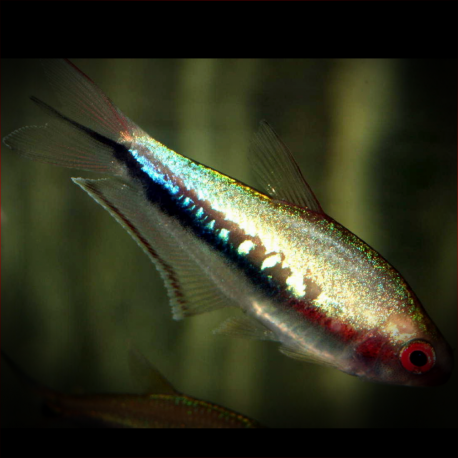More info
Datasheet
| Minimum Tank Size | 115 litres / 30.38 US gallons |
| Maximum Size | 3.6cm / 1.42inches |
| Temperature | 20°C / 68.00°F - 28°C / 82.40°F |
| Hardness | 1.01dgH / 18ppm - 10.03dgH / 179ppm |
| pH | 5.0-7.2 |
General Description
Native to western Colombia, the Nematobrycon Lacortei, commonly known as the Rainbow Tetra, belongs to the Characidae family within the Characiformes order. Reaching a maximum size of 3.6cm, this species displays distinctive color patterns and slight morphological differences from its close relative, N. palmeri.
Aquarium Setup
For optimal maintenance, a minimum tank size of 115 liters is recommended. The Rainbow Tetra thrives in a well-furnished aquarium with live plants and a natural-looking setup comprising soft, sandy substrate, wood roots, and branches creating shady spots. Adding dried leaf litter enhances the natural feel and promotes the growth of beneficial microbe colonies.
Behaviour
Generally peaceful, the Rainbow Tetra is suitable for community aquariums, but adult males can exhibit territorial and aggressive behavior towards similarly-shaped species. Maintaining them alongside characids, gasteropelecids, loricariid catfishes, and non-predatory cichlids is advisable. Keeping a group of 8-10 specimens with a mix of males and females, along with other schooling fish, can enhance their natural behaviors, especially when competing for female attention or hierarchical position.
Feeding and Diet
Considered opportunistic omnivores, Rainbow Tetras thrive on a diet of small live and frozen foods like chironomid larvae, Daphnia, and Artemia. Offering high-quality dried flakes and granules supplements their diet and helps maintain their condition and vibrant colors.
Reproduction & Dimorphism
Breeding Rainbow Tetras is similar to N. palmeri, with dimly-lit aquariums containing fine-leaved plants or spawning mops being ideal breeding setups. Soft, acidic water with specific parameters and a temperature range of 75-80°F facilitate successful spawning. Adult males exhibit more elaborate fins and red eyes, while females have blue-green eyes and appear fuller-bodied, particularly when gravid.
Habitat and Distribution
Rainbow Tetras are endemic to the Río San Juan river system in western Colombia, specifically inhabiting small, isolated forest pools in the headwaters of the Río Calima above the Calima Dam. Their distribution is primarily limited to this region, showcasing a specialized habitat preference.

